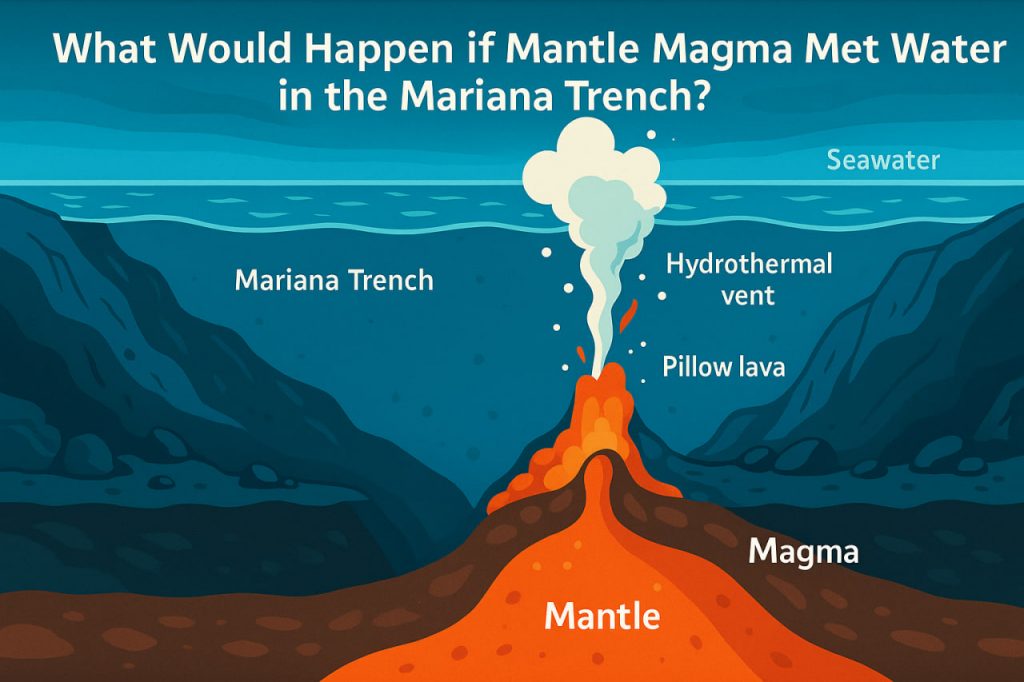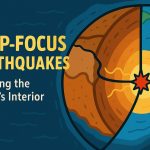The Mariana Trench is the deepest known part of Earth’s oceans, reaching nearly 11 kilometers (7 miles) below sea level. Located in the western Pacific Ocean, this trench lies above a subduction zone — where one tectonic plate is forced beneath another. But what if large amounts of magma from the Earth’s mantle were to suddenly rise and interact with the cold, pressurized seawater at this extreme depth?
Magma and Water: A Volatile Mix
When magma comes into contact with water, it typically results in a phreatomagmatic eruption — an explosive reaction caused by rapid cooling and steam generation. On land or in shallow water, this can lead to violent explosions. However, at the depth of the Mariana Trench, where pressure is immense, the results would be significantly different.
Extreme Pressure Dampens Explosions
At 11,000 meters, the water pressure exceeds 1,000 times atmospheric pressure. This pressure prevents steam from expanding rapidly, meaning explosions would likely be much smaller or even suppressed entirely. Instead, the magma would cool and solidify quickly, forming pillow lava and hydrothermal structures on the trench floor.
Formation of New Geological Features
If enough magma reached the trench floor, it could create new volcanic vents, ridges, or seamounts. Over time, these features might support unique ecosystems based on chemosynthesis, similar to other hydrothermal vent communities found in deep ocean environments.
Chemical Reactions and Gas Release
The intense heat from magma would cause chemical reactions between the molten rock and seawater, releasing gases like carbon dioxide, hydrogen sulfide, and methane. These gases could alter local water chemistry but would not likely reach the surface due to depth and dilution.
Would It Trigger a Tsunami?
Because the reaction is deep and likely non-explosive, it would not trigger a tsunami unless accompanied by a landslide or major seafloor uplift. However, if tectonic activity caused the magma release, an earthquake could potentially trigger larger-scale effects, depending on the movement of the plates.
Is This Scenario Realistic?
While small amounts of magma do occasionally reach the trench through volcanic arcs nearby, a massive, sudden surge from the mantle directly into the trench is unlikely. The Earth’s crust is extremely thick in this area, and mantle material rarely rises vertically on this scale.
But, unfortunately, scientists also voice a terrible scenario where millions of tons of molten magma meet billions of tons of water when the crust breaks in the Mariana Trench due to geological processes, such as megathrust earthquake. The consequences of such a hydro-shock are described as fatal for all of humanity.
Glossary
- Mariana Trench – the deepest part of the world’s ocean, located in the western Pacific
- Magma – molten rock from beneath Earth’s crust
- Mantle – the layer of Earth beneath the crust, where magma originates
- Phreatomagmatic eruption – an explosive event caused by magma meeting water
- Hydrothermal vent – a fissure on the ocean floor emitting heated water and minerals
- Pillow lava – rounded lava formations created when magma cools rapidly underwater
- Subduction zone – an area where one tectonic plate is pushed under another
- Tsunami – a large ocean wave usually caused by underwater earthquakes or landslides
- Hydraulic shock (hydro-shock) – a pressure surge in a system filled with liquid caused by a rapid change in the flow rate of this liquid.


